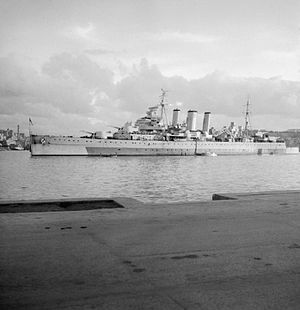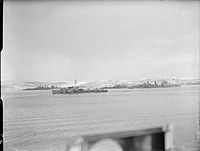HMS Cumberland (57)
This article includes a list of references, related reading, or external links, but its sources remain unclear because it lacks inline citations. (June 2008) |

| |
| History | |
|---|---|
| Name | HMS Cumberland |
| Builder | Vickers-Armstrong, Barrow in Furness |
| Laid down | 18 October 1924 |
| Launched | 16 March 1926 |
| Commissioned | 23 February 1928 |
| Recommissioned | 1951 |
| Decommissioned | 1946 |
| Fate | Sold for scrap 1959 |
| General characteristics | |
| Displacement | list error: <br /> list (help) 9,750 tons (9,010 t) standard 13,450 tons (13,670 t) full load |
| Length | 630 ft (190 m) |
| Beam | 68 ft 3 in (20.80 m) |
| Draught | 16 ft 3 in (4.95 m) |
| Propulsion | list error: <br /> list (help) Eight Admiralty 3-drum boilers Four shaft Brown Curtis geared turbines 80,000 shp |
| Speed | 31.5 knots (58.3 km/h) |
| Range | 3,100 nautical miles at 31.5 knots (5,740 km at 58 km/h), 13,300 nautical miles at 12 knots (24,600 km at 22 km/h); 3,400 tons (3,450 t) fuel oil |
| Complement | 679 (710 as flagship) |
| Armament | list error: <br /> list (help) Original configuration:
|
| Armour | list error: <br /> list (help) Original configuration:
|
| Aircraft carried | Three aircraft with one catapult, removed in 1942 |
| Notes | Pennant number 57 |
HMS Cumberland was a County class heavy cruiser of the Royal Navy that saw action during the Second World War.
Career
Cumberland served on the China Station with the 5th Cruiser Squadron from 1928 until 1938, returning to the UK in March 1935 for a refit. In 1938, she joined the 2nd cruiser squadron on the South American station.
In the South Atlantic
At the start of the Second World War in 1939, Cumberland was assigned to 2nd Cruiser Squadron Force G, the South American Division.[1] At the start of December she was forced to self-refit in the Falkland Islands, thus depriving the force of their strongest unit. Without her, HMS Exeter, Ajax and Achilles engaged the German raider Admiral Graf Spee in the Battle of the River Plate on 13 December. Cumberland received a garbled indication that a contact was being made and moved north to reinforce, arriving at the River Plate at 22:00 14 December, after steaming for 34 hours. The Graf Spee had put into neutral Montevideo and was trapped there, as Cumberland along with Ajax and Achilles (Exeter having been heavily damaged) patrolled the estuary, resulting in the Graf Spee being scuttled by her crew on 17 December.

South African service
After this she sailed to Simonstown, South Africa, spending between January and February undergoing a refit. She then escorted convoys along the African coast, bound for the Middle East. In July she was tasked, along with her sister, HMS Cornwall, with hunting down the German commerce raider Thor. Whilst on patrol, she intercepted and sank the Vichy French merchant Poitiers, which had been carrying ammunition to the Ivory Coast. Later that month she attacked Dakar, suffering damage from a French coastal battery. A single 9.4 inch shell penetrated the hull just above the armour belt. Her main machinery was put out of action due to the loss of feed water to the boilers and she had to return to the Simonstown dock yard for repairs which lasted until November. In December, Cumberland was again hunting for the merchant raider Thor, but the search proved unsuccessful.
Arctic convoys
In October 1941 Cumberland joined the 1st Cruiser Squadron Home Fleet escorting the Arctic convoys until January 1944, winning the battle honour Arctic 1942-1943.
In the Far East

She was then transferred to the Far East, as part of 4th Cruiser Squadron Eastern Fleet. In July she was involved in the bombardment of Sabang, and in September she carried out raids on Northern Sumatra. In October the Eastern Fleet was used as a diversion force and attacked the Nicobar Islands, so that the landings on Leyte could take place, unfortunately the diversion did not succeed. During this period, Cumberland won the battle honours Sabang 1944 and Burma 1945. On 7 February 1945, Cumberland was back in Simonstown to have her rudder removed, and the following month completed an inclination experiment in the wet dock before successfully completing her trials. During April whilst operating in the Indian Ocean Cumberland was involved in the shelling of Sabang. In May she was also responsible for the shelling of Nicobar and Port Blair in the Andaman Islands group. On 3 September, in company with the cruiser HMS London, they put ashore marine detachments at Sabang in Sumatra after the surrender of Japan the previous day. She arrived at Jakarta on the 15th, in company with one frigate and four Australian minesweepers. Because of the disturbances ashore between the Indonesian Nationalists and the Japanese, a British Battalion was not landed on Batavia before 29 September.
Postwar
She returned to the United Kingdom on 12 November 1945 and transported troops until June 1946, when she was placed in reserve until 1949. She was then refitted at Devonport (1949-1951) as a trials cruiser, with lattice masts, new directors and added accommodation. The original armament was entirely removed, but individual light weapons were added from time to time for trials, and the new quick firing 6 inch MK26 twin automatic turret for the Tiger class cruisers was tested on B barbette, she also undertook pre wetting trials against radio-active fallout. In April 1955, glass-reinforced plastic, used today for constructing warships of as much as 700 tons made its debut, when a new 29 foot general purpose sea-boat made of this material was taken onboard Cumberland for the start of her summer season of tests in the Mediterranean. For the 1956 film The Battle of the River Plate, Cumberland played herself (being partly disarmed). In August 1956, at the start of the Suez crisis, Cumberland was deployed in trooping in reinforcements to Cyprus. In November 1959, Cumberland left Malta for Barrow-in-Furness.
Cumberland was broken up by Cashmore, Newport, arriving there on 3 November 1959.
References and notes
- ^ p.66, Boniface
Sources
- Boniface, Patrick, HMS Cumberland: A Classic British Cruiser in War and Peace, Periscope Publishing Limited, London, 2006
Further reading
- British and Empire Warships of the Second World War, H T Lenton, Greenhill Books, ISBN 1-85367-277-7
- Conway's All the World's Fighting Ships, 1922-1946, Ed. Robert Gardiner, Naval Institute Press, ISBN 0-87021-913-8
- Colledge, J. J.; Warlow, Ben (2006) [1969]. Ships of the Royal Navy: The Complete Record of all Fighting Ships of the Royal Navy (Rev. ed.). London: Chatham Publishing. ISBN 978-1-86176-281-8.
- HMS Cumberland at U-boat.net
